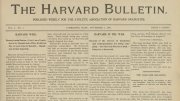Don’t be misled: n+1 is not a math quarterly. It’s a twice-yearly literary magazine whose first issue declared, in 2004, “We are living in an era of demented self-censorship…a time when a magazine like Lingua Franca can’t publish, but Zagat prospers.” Seven issues later, at more than 200 pages apiece, the Brooklyn-based n+1 continues to air trenchant views. “Pointed, closely argued, and often brilliantly original critiques of contemporary life and letters,” wrote A.O. Scott in the New York Times Magazine, describing n+1’s enterprise as “a generational struggle against laziness and cynicism.” Even intellectuals in Europe have championed it: theater director Alessandro Cassin, in Milan’s Diario, for example, cited n+1’s “brand of intellectual bravery that has its roots in magazines like T.S. Eliot’s Criterion and the Partisan Review.”
Three of the four founding editors—Keith Gessen ’97, Mark Greif ’97, and Benjamin Kunkel ’96—honed their literary sensibilities at the Harvard Advocate. They’re no lightweights: Gessen and Kunkel have published novels, and Greif teaches at the New School in New York. (Executive editor Chad Harbach ’97, another Advocate alumnus, recently completed a novel of his own.) The fourth founding editor, Columbia graduate Marco Roth, catalyzed the venture. “Now we had somebody from the ‘outside,’” Gessen says. “It would have been embarrassing to have spent so much time talking about starting a magazine and not actually doing it.”
Each issue follows a similar format, beginning with “The Intellectual Situation,” a compilation of the editors’ views on, for example, the undermining of neoliberalism, the psychology of global warming, or the gentrification of Park Slope, Brooklyn. Then comes “Politics,” where one recent essay, “On Repressive Sentimentalism,” considered the relationship between gay marriage and abortion rights.
Extended essays—they can run 10,000 to 15,000 words—occupy the bulk of the magazine, along with several fictional works and, occasionally, poetry. Topics range from the emergence of the “neuro-novel,” the persecution of Armenians, and the impact of a brother’s suicide to the sundry ways food is viewed around the world. In “Jessica Biel’s Hand: The Cinematic Quagmire,” film critic A.S. Hamrah critiques dozens of recent movies about terrorism that he’d spent the summer watching. Greif’s “Mogadishu, Baghdad, Troy” explores the weapons deployed in Iraq through the lens of Homer’s Iliad. “We are interested in history and the connections between politics and literature,” Gessen explains. They also have a contemporary focus. “We deal with living writers, living musicians, actual TV shows,” says Gessen. “There’s a lot of pop culture in our magazine.”
Each issue concludes with reviews of books and sometimes other publications. Black-and-white illustrations and photographs introduce some articles, and advertisements for books, films, and music appear throughout. Each issue has a theme—e.g., “Correction,” “Negation,” “Reconstruction,” “Happiness”—that’s determined after the content is compiled. Author Francine Prose ’68 calls the magazine quirky. “I hate that word, ‘quirky,’” she says, “but [n+1] has a kind of heartening connection to things that are unique, eccentric, and individual.” Prose calls its content “accessible, original, and beautifully written. It’s very literary in the best sense of the word.”
The name n+1, conceived in a moment of frustration, comes from an algebraic expression. “Keith and I were talking,” Harbach recalls, “and he kept saying, ‘Why would we start a magazine when there are already so many out there?’ And I said, jokingly, ‘N+1’—whatever exists, there is always something vital that has to be added or we wouldn’t feel anything lacking in this world.” The founders did perceive a literary void: a dearth of cohesive philosophical ideas. Journals like The Baffler and Hermenaut, which critiqued contemporary culture and thrived in the 1990s, had disappeared; meanwhile, they saw an “institutionalization” of magazines like the Nation, the New York Review of Books, andthe New Yorker. “There need to be organizations that are not as worried about offending people as you have to be if you have a million subscribers,” says Gessen.
Unlike many literary journals, n+1 is, by design, distinct from academia. “Academia is the site of so much thinking in this country,” says Harbach. “Part of our project is to bridge that gap. We want all of the thoughtfulness and deep engagement that comes from the university, but we want it in a style that is portable and publicly accessible.” Regarding their predilection for long pieces, Greif says, “We are creating a long print archive in an era of the short sound bite.”
There is also a website (nplusonemag.com), updated weekly with shorter, more topical pieces, plus a Small Book Series, whose latest product is What Was the Hipster, based on a New School seminar on the “hipster” persona that emerged—briefly—at the turn of the twenty-first century. Other projects include the online book review N1BR, and a spinoff, the arts journal Paper Monument. In 2010, HarperCollins will publish Diary of a Very Bad Year, Gessen’s interviews with an anonymous hedge-fund manager, first published on n+1’s website and in the magazine. “We’re a growing empire!” Greif says.
Nevertheless, after five years, there’s only one paid staff member. Half of n+1’s income comes from its 2,000 subscribers, a quarter from ads, and a quarter from bookstore sales. Last year they received $40,000 from a benefactor, “about a third of our annual budget,” Gessen says.
N+1 has met with mixed response—accused of elitism and negativity and applauded for its passion and quality. Some have puzzled over the editors’ resolve to publish print in a digital age teeming with blogs and social media sites. “If you still think a print magazine has value,” Gessen says, “its function has to be different.” The editors believe there are audiences for their products. Gessen describes conversations with supporters who say, “I think it’s great what you’re doing, I think it’s really important—but you understand, nobody cares except me.”
“When you hear enough people talking like that,” he says, “you want to tell them, ‘If you would all just admit in public that you care about this stuff, then maybe we could get somewhere.’”









